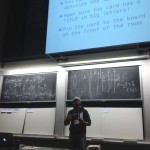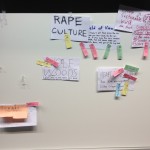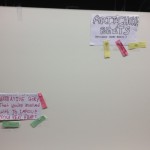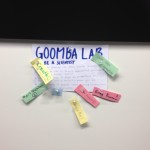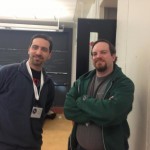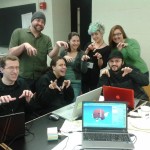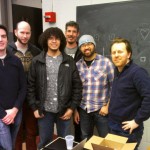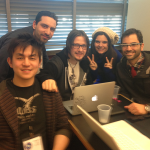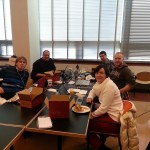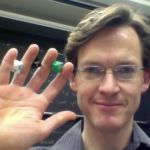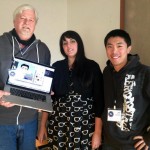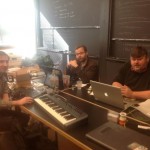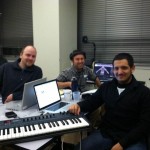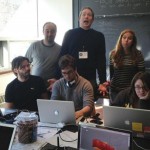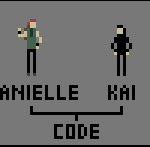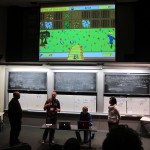Global Game Jam 2013 – 48 hours, 100 jammers… 27 games!
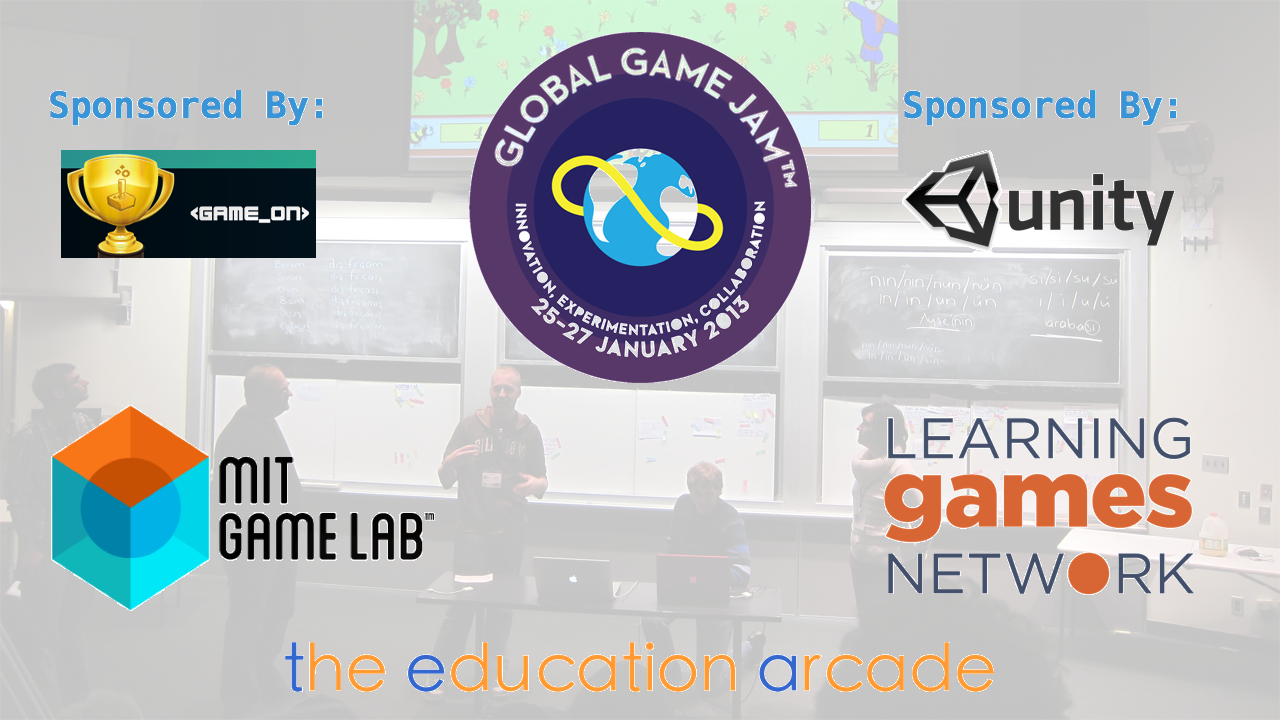
This past January, we hosted the 5th annual Global Game Jam at MIT along with the MIT Education Arcade and Learning Games Network. Over 100 people got together (many of whom had never met or worked with each other before) and made a record 27 games at our site! This was the biggest Jam yet, and not just for our site. We were one of over 300 locations in 60+ countries, all of which hosted over 16,000 people to make over 3000 games!
Every year, all of the jammers make games inspired by a common theme. This year, the theme was the human heartbeat. After a keynote presentation with inspirational presentations from Erin Robinson and Bret Victor, the jammers were shown this clip:
After the video, the jammers split up into work rooms and worked on brainstorming and concepting short pitches of game design ideas. About 40 ideas were presented to the all of the jammers, and the hard work of forming teams began! Jammers added themselves to the pitch ideas based on interest and skills and in the end, about 25 teams were created, most of which can be seen on our pitch board below:
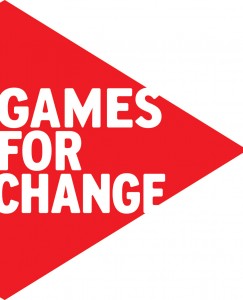 Our site also happened to be one of 12 that supported Games for Change. Our jammers were encouraged to take on their challenge: making games that touch on a political, environmental, or social issue. Before the Jam started, Scot Osterweil spoke to our jammers about the four freedoms of play (to experiment, to fail, to try on different identities, and of effort). To help the jammers out during the Jam, researchers, designers, and staff from the Education Arcade and Learning Games Network provided advice on making games for impact and games for learning. The games that were developed for this challenge were:
Our site also happened to be one of 12 that supported Games for Change. Our jammers were encouraged to take on their challenge: making games that touch on a political, environmental, or social issue. Before the Jam started, Scot Osterweil spoke to our jammers about the four freedoms of play (to experiment, to fail, to try on different identities, and of effort). To help the jammers out during the Jam, researchers, designers, and staff from the Education Arcade and Learning Games Network provided advice on making games for impact and games for learning. The games that were developed for this challenge were:
- Beast Wars: 8 Bits of Vengeance (a real time strategy game about ecology and evolution)
- Elementia (an educational adventure game combining the elements and a murder mystery)
- Field of View (a game that “models the everyday experience of many people around the world, who have to deal with hostile comments and the threat of violence, simply for existing in public”)
- Goomba Lab (a puzzle game intended to teach scientific inquiry skills and critical thinking to middle school students (age 11-14).
- Heart of the Hive (a bee management simulation game about colony collapse disorder)
- Managed Consequence (“A rudimentary exploration of medical management app gamification”)
- Monster Healthcare (a game that asks “players to balance the costs of administering treatment with keeping members on their Monster Insurance Plan”)
- Organ Trail (a game about being on the waiting list for an organ transplant, and the influence you have on moving up that list)
- Robot Finds Kitten 2 (adaptations of a previous game where the player must “Navigate through an indistinct world of garbage and brokenness left by a now-gone humanity”)
- What The Frack? (a game about the coming natural gas boom)
Jammers who worked on these games included current teachers, journalists, professional (and often independent) game developers, and college students from local schools (not just MIT, but also Berklee College of Music and Rhode Island School of Design). Our youngest programmer was still in high school, who came to the jam with her father. Not only was this the biggest group we’ve had at our jam site, but the most diverse! We also had a few guest testers from local elementary, middle, and high schools drop by the site on Saturday to help the jammers understand their games from another perspective (as well as to cheer the teams on!).
Many of the games above (and below) also attempted the inclusivity diversifier, using the IGDA’s guides for including players with a given disability. Jammers took into account people with various visual impairments ranging from color blindness to vision loss to blindness in their designs.
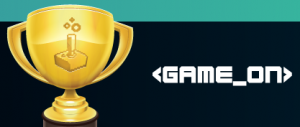 We also tasked our jammers with making games that could be played in a web browser without external support, encouraging them to submit their games to the Mozilla Game On! competition. Mozilla was a sponsor of both the Global Game Jam and our individual site – much pizza was ate on their behalf! Chloe from Mozilla came by the site to talk to jammers about the Game On festival, but also to help guide them to tools and techniques to use in their web-based games. Games made that fit this condition include some of the above games, as well as:
We also tasked our jammers with making games that could be played in a web browser without external support, encouraging them to submit their games to the Mozilla Game On! competition. Mozilla was a sponsor of both the Global Game Jam and our individual site – much pizza was ate on their behalf! Chloe from Mozilla came by the site to talk to jammers about the Game On festival, but also to help guide them to tools and techniques to use in their web-based games. Games made that fit this condition include some of the above games, as well as:
- Artichoke ♥ Beet (“An artichoke follows its heart in search of its beet.”)
- EKG Runner (“A game where you run through your own life on the EKG Machine”)
- Empathy/Wolf (“a game about moving through a wolf-infested wood and helping people to escape. Also, empathy. And wolves.”)
- Go First (“You are entering the mind of who you are communicating with. Putting yourself in their shoes to understand their perspective in the world.”)
- Heartchers (“a floaty 2 player head 2 head shoot ’em up for tablet devices”)
- Not Alone (“Escape the Mantion! But watch out — you’re not alone!”)
- To The Heart of It (“a GPS powered scavenger hunt in your favorite neighborhood” – they used MIT!)
- Yarn Ball (“a 2D puzzle game where you play as a ball of yarn in a dark labyrinth.”)
 Our other site sponsor was Unity Technologies. Carl from Unity was on site, as were many of the Boston Unity Group members and organizers, to help jammers create games using the Unity cross-platform development environment. Many of the games above used Unity, as well as the following:
Our other site sponsor was Unity Technologies. Carl from Unity was on site, as were many of the Boston Unity Group members and organizers, to help jammers create games using the Unity cross-platform development environment. Many of the games above used Unity, as well as the following:
- Secret Surgeon (an augmented reality game where you fix broken hearts)
- EKG Excite Bike (“An Excite Bike player finds himself on a new course: the pulsing track of an EKG machine!” — the team’s one word design document: ‘radical!’)
- Heart to Heart (a matching game using colorblind safe colors)
- Heartbeat-Em-Up (“the story of one Hero Heart, walking the street, laying down the beat, knocking enemies off of their feet… until your mission is complete.”)
- Sound Maze (find the heart of the maze).
- Zombie Beats (find and rescue survivors but avoid the zombies)
Other games made at our jam were:
- BRANDO (a dice game that exercises math and probability skills)
- Mechanical Heart (a “platformer about a gardening robot hoping to bring life to an abandoned world”)
- Heartbreaker (“Use your heart to break hearts with your heart and earn hearts” and puns!)
That’s a lot of games!
As the organizer for our site, I was incredibly worried in the months leading up to the Global Game Jam. Since the previous year our lab has changed its name, moved to a new location, and taken on a new mission. I wasn’t sure this Jam would be a success – I was afraid people wouldn’t come or that the space just wouldn’t work. I must say now that my fears were unfounded – our new space worked just as well as our old jam site (and almost better in that we could fit more people using MIT classrooms and a lecture hall than the lab setup we used to have). Not only did we get people to come to the Jam, but we had people come who’d both never been to the lab before and had never been to any game jam or made a game before! New networks were created, of designers, developers, and educators. None of this could have been possible without support from our partners at the Education Arcade and Learning Games Network, our sponsors Mozilla and Unity, and of course our jammers!
You can view the final presentations of our jammers’ games here:
We’ll be hosting more game jams in the coming months at the Game Lab. Keep a look out on our site and Twitter feed (@MITGameLab) for more details!

